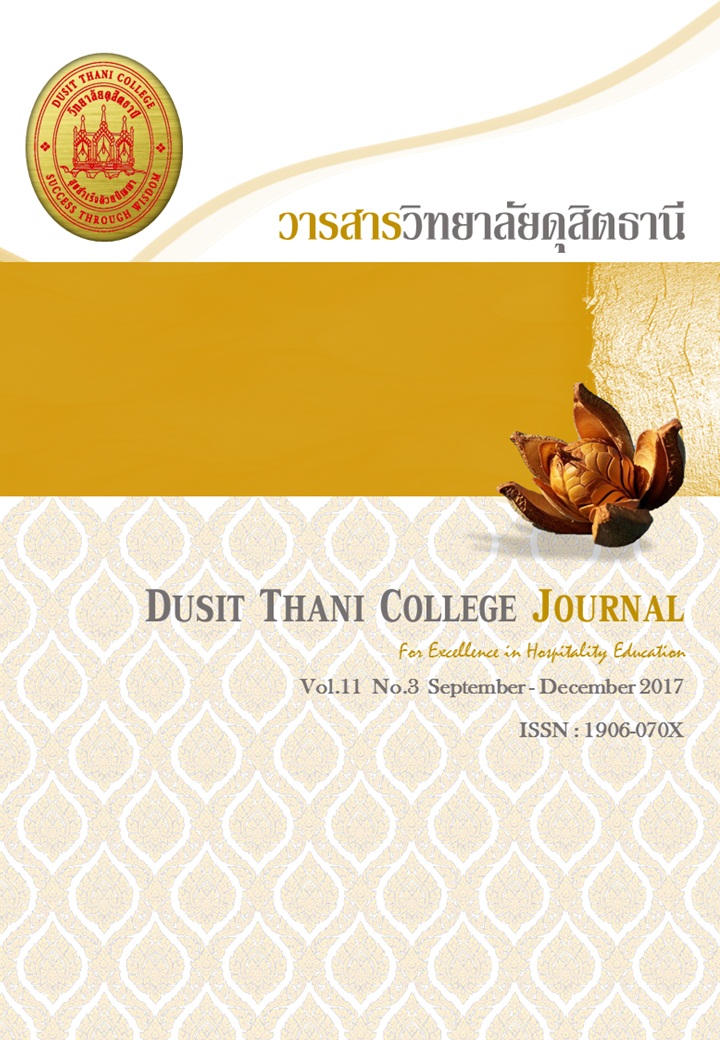Smartphone Addiction of Students: A Scale Development in the Context of Undergraduate Students in Bangkok
Main Article Content
Abstract
The objective of this research was to develop a smartphone addiction scale. The sample consisted of 986 undergraduate students in Bangkok. The data was collected by using 30 item Smartphone addiction scale. Smartphone addiction scale was considered for its content validity by academic experts and its reliability was 0.94. The results of second order confirmatory factor analysis showed that smartphone addiction had 6 factors; salience, mood modification, loss of control, withdrawal, conflict, and relapse, resulting in a 24-items scale. The convergent validity and construct reliability of this scale were accepted. The average variance extracted was ranged 0.52 - 0.79 and the construct reliability was ranged 0.79 - 0.93.
Article Details
Article Screening Policy
- All research and academic articles to be published must be considered and screened by three peer reviews in the relevant field / article.
- All articles, texts, illustrations and tables published in the journal are the personal opinions of the authors. Editors don't always have to agree. And no responsibility whatsoever is the sole responsibility of the author.
- The articles to be published must never be published. Where did you first publish? And not in the consideration of other journals If the audit found that there has been a duplicate publication It is the sole responsibility of the author.
- Any article that the reader sees as being plagiarized or impersonated without reference. Or mislead the work of the author Please let the journal editor know it will be your greatest blessing.
References
of Psychiatric and Psychological Views. Int J Prev Med. 3 (4): 290-294.
Blanchi, A. & Phillips, J. G. (2005, February). Psychological Predictors of Problem Mobile
Phone Use. CyberPsychology & Behavior. 8(1): 39-51.
Bolle, C. (2014). “Who is a smartphone addict?” The impact of personal factors and
type of usage on smartphone addiction in a Dutch population. Netherlands:
University of Twente.
Griffiths, M. D. (1995). Technological addictions. Clinical Psychology Forum. 76 (1): 14-19.
. (2005). A ‘components’ model of addiction within a biopsychosocial
framework. Journal of Substance Use. 10 (4): 191-197.
Hair, J. F. et al. (2010). Multivariate data analysis: a global perspective. (7th ed.). Upper
Saddle River, NJ: Prentice-Hall.
Kline, R. B. (2005). Principles and Practice of Structural Equation Modeling with the SIMPLIS Command Language. 2nd ed. Chicago, IL: Scientific Software International, Inc.
Kwon, M. et al. (2013). Development and Validation of a Smartphone Addiction Scale (SAS). PLoS ONE. 8(12): 1-7.
Merlo, L. J., Stone, A. M., & Bibbey, A. (2013). Measuring Problematic Mobile Phone Use:
Development and Preliminary Psychometric Properties of the PUMP Scale. Journal
of Addiction. 2013: 1-7.
National Statistical Office. (2016). The 2016 Household Survey on the Use of Information and Communication Technology. Retrieved April, 3 2016, from
https://service.nso.go.th/nso/web/survey/surtec5-1-3.html. (in thai)
Office of Higher Education Commission. (2016). Higher Education Institution affiliated
with Higher Education Commission. Retrieved June, 1 2016, from https://www.mua.
go.th/ohec/Department.html. (in thai)
Phachongchit Phapoom. (2003). Computer/Internet Addiction: Prevention and Intervention.
Journal of Mental Health of Thailand. 11(1): 42-54. (in thai)
Rovinelli, R. J. & Hambleton, R. K. (1976). On the Use of Content Specialists in the
Assessment of Criterion-Referenced Test Item Validity. Retrieved April, 2 2016, from https://files.eric.ed.gov/fulltext/ED121845.pdf
Salehan, M. & Negahban, A. (2013). Social networking on smartphone: When mobile
phone become addictive. Computers in Human Behavior. 29: 2632-2639.
Schumacker, R. E. & Lomax, R. G. (2010). A Beginner’s Guide to Structural Equation
Modeling. 3rd ed. New York: Taylor and Francis Group, LLC.
Suwimol Tirakanan. (2008). Creating a Variable Measurement Tool in Social Science
Research: A Practical Guide. 2nd ed. Bangkok: Chulalongkorn University Press.
Sucheera Phattharayuttawat. (2002). Manual of Psychological Testing. Bangkok: Medical Media.
Walsh, S. P., White, K. M., & Young, R. M. (2008). Over-connected? A qualitative exploration
of the relationship between Australian youth and their mobile phones. Journal of
Adolescence. 31(1): 77-92.
. (2010). Needing to Connect: The Effect of Self
and Others on Young People’s Involvement with their Mobile Phones. Australian
Journal of Psychology. 62(4): 194-203.
Young, K. S. (1999). Internet addiction: Symptoms, Evaluation, And Treatment. Innovations
in Clinical Practice. Retrieved January 10, 2015, from https://netaddiction.com/
articles/symptoms.pdf

